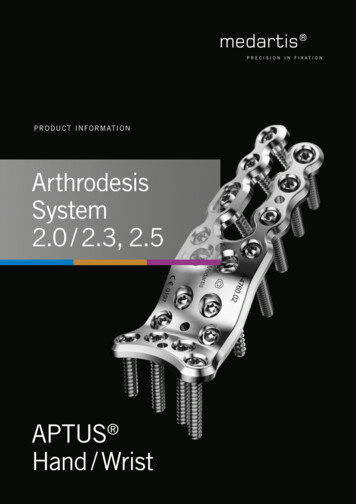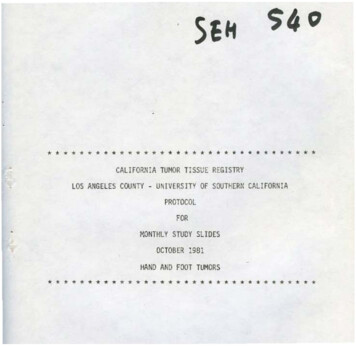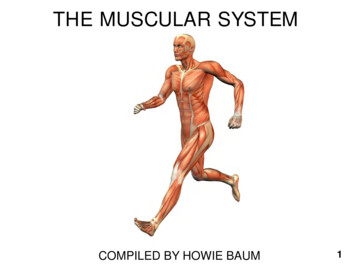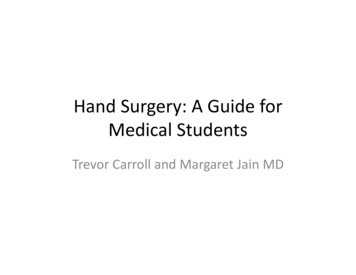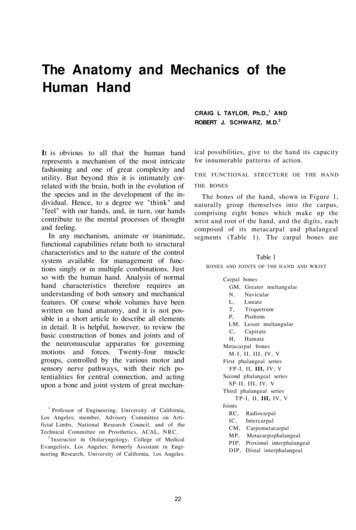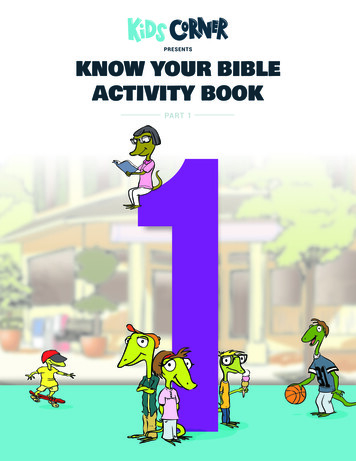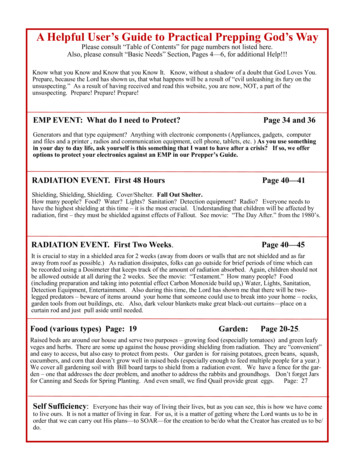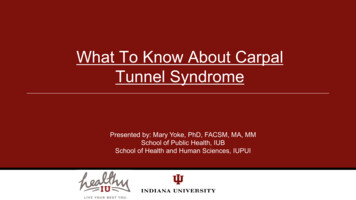
Transcription
What To Know About CarpalTunnel SyndromePresented by: Mary Yoke, PhD, FACSM, MA, MMSchool of Public Health, IUBSchool of Health and Human Sciences, IUPUI
What is Carpal Tunnel Syndrome? AKA: median nervecompression/entrapment A repetitive stress injury thatcauses pain, tingling, andnumbness in the hand, oftenat the base of the palm
What is Carpal Tunnel Syndrome? The median nerve is compressedwhen the tendons in the carpaltunnel become inflamed Primarily affects the thumb, indexand middle fingers More common in females More common over age 50
- Along with the median nerve, 9 fingertendons pass through the carpal tunnel(A tendon connects a muscle to a bone)Improper use and repetitivestress on wrist muscles cancause tendons to becomeinflamed and swollen, causingpressure on the mediannerve
Repetitivestress onmuscles andpoor wristalignmentTendons inthe carpaltunnelbecomeinflamed andswollenIncreasedpressurewithin thecarpal tunnelMediannerve iscompressedTingling,numbness,and pain inthe hand andfingers result
Symptoms: Can be worse at night May interfere with sleep Symptoms can increase with writing, typing, using a blow dryer orpower tool, housework Your hand may feel weak, or the fingers may feel numb, or both You may tend to drop things Fine finger-control moves (e.g. fastening buttons) may be difficult
Possible Causes of CTS Work that places a heavy demand on your wristVibrating toolsPoor wrist position while sleepingWrist arthritisHormonal changes that increase fluid retention or swelling ofconnective tissues (e.g. during pregnancy)Some medicationsDiabetesWrist fractureObesitySmall carpal tunnel (genetic)
FYI: Finger numbness can also be caused by: Cervical radiculopathyDiabetesRaynaud’s diseaseDe Quervain’s tenosynovitisRheumatoid arthritisUlnar nerve entrapmentMultiple SclerosisStrokeBottom line: see your physician for a proper diagnosis!
Diagnosis and Tests for CTS Tinel’s test for median nerve injury (tapping the nerveat the wrist to check for tingling or numbness) Phalen’s (wrist flexion) test (hold position for 30-60 sec tocheck for pain, tingling, or numbness) EMG and nerve conduction tests Grip strength Pinch test
Treatment of CTS SplintsDrugs (pain killers and steroids)Ultrasound (may produce anti-inflammatory effect)SurgeryPhysical Therapy and ExerciseAlternative therapies (acupuncture,osteopathy, yoga, Alexander technique,biofeedback, massage, etc.)
Splints, Braces, ProductsClassic CTS braceGel wrist supportWrist ice-packAnti-vibration glovesPush-up stands
Adapting Your Environment SleepingThe worst!Better
CTS and Computers 30% of frequent computer users complain of tingling, burning, ornumbness of limbs 10% of frequent computer users have a diagnosis of carpal tunnelsyndrome Taking insufficient breaks while working at computers is a keyfactor in the development of CTS
Adapting Your Environment Keyboard & Mouse ErgonomicsMouse pad with wrist restSplit keyboard with wrist rest
Adapting Your Environment
Adapting Your EnvironmentEr,Problematic?
CTS and Video Games How you hold and grip the controller is key Repetitive poor alignment can lead to injury
Feel-Good Moves (do them for no otherreason than that they feel good!) Youdeserve it! Breathe!!Shoulder rollsNeck movesSide bendsRound and release (add a chest stretch)Wrist rolls and finger stretchesWindshield wiper move with lower body(add upper body moves) Ankle rolls, point and flex, wiggle toes
Adapting Your ExercisesPlanks, Push-ups, and PressesmodificationPush up/plank standsmodificationPlankmodificationBarbell bench press
Self-Management of CTS Take regular breaks! Do regular exercises Make sure you are sitting inthe correct position
Modifying Exercises and MakingSure You’re in Good AlignmentFace pullDownward-facing dogmodificationLateral raiseUpright row
The Key: Keep your wrist in neutral whenever possible!(This helps to rest the median nerve)Repetitive wrist flexionand extension (carpaltunnel gets smaller inthese positions, circulationto the hand decreases andpressure in the carpal tunnelincreases)Ozcan H, et al. Dynamic doppler evaluation of the radial and ulnar arteries in patients with CTS. Am J Roentgenol 2011;197:W817-20Seradage H, et al. In vivo measurement of carpal tunnel pressure in the functioning hand. Journal of Hand Surgery 1995;20A:855-859
What Else Can You Do to Help with Pain? TractionAcupressure/AcupunctureOver the counter medsSteroid injectionOT or PT with a certified handtherapist Ice Rest/take breaks from repetitivetasks SurgeryTransverse ligament is cut
Additional Coping StrategiesOwch! When shopping, limit the weight of your shopping bags Consider using a backpack or a bag with a shoulder strap Consider avoiding handshakes (alternatives: elbow bump or cupyour hands around the other person’s hand) Instead of clapping, shout “bravo”, stomp your feet, “shine” withyour hands Careful with driving; maintain a neutral wrist on the steering wheel Push doorbells and elevator buttons with an elbow, knuckle, orumbrella Minimize texting—talk instead
Instant Relief?Self CTS massage with mini-ballor mini-foam rollerAcupressureShake it outhttps://www.youtube.com/watch?v kkQs9ytO20MHeat or ice—ask yourdoctor which is best!(most will recommend heat)Let’s do this!CTS massage
Exercises Make a fist, then straighten your fingers (fist tostop sign). 5-10x Wrist flex and extend Wrist extension with a band Active finger flexion
Prayer stretch
The median nerve can become pinched withCTS. Nerve gliding/flossing may help. . .
Upper body exercises that can help:Prone reverse fly variations (works scapular musclesessential for good upper body posture)Wrist extension stretchSpinal twistLateral neck stretchesWall slides
Hopeful Outcomes:1. Your hand starts to feel better2. Your hand starts to work better
Functional Status Scale (keep track of how your hand deratedifficultySeveredifficultyCannot do atall due tohand or wristsymptomsWriting12345Buttoning clothes12345Holding a book while reading 12345Gripping smartphone12345Opening jars12345Household chores12345Carrying grocery bags12345Bathing and dressing12345To get your score, simply add up the numbers you circled and divide by 8
Summary Take breaks from repetitive tasksWear splints on your wristsLighten up (relax your grip/reduce the force you’re using)Mind your flexion (stay in neutral as much as possible)Stretch it outTry over-the-counter medsSlather on some pain relief (e.g. topical menthol such asBiofreeze)
Resources Johnson, J. (2020) Treat your own carpal tunnel syndrome: treatment and prevention strategies forindividuals, therapists, and employers. Self-published.Madenci, E. et al (2012) Reliability and efficacy of the new massage technique on the treatment inpatients with carpal tunnel syndrome. Rheumatol Int, 32:3171-3179.Manente, G. et al. (1999) A relief maneuver in carpal tunnel syndrome. Muscle & Nerve, 22:15871589.Montgomery, K. (2012) End your carpal tunnel pain without surgery: the Montgomery method.Premoselli, S. et al. (2006) Neutral wrist splinting in carpal tunnel syndrome: a 3- and 6-month clinicaland neurphysiologic follow-up evaluation of night-only splint therapy. Europa Medicophysica, 42:121126.Rudford, L. (2015) Carpal tunnel syndrome: causes, symptoms, treatment, exercises, management,therapies, and prevention. IMB Publishing.
End your carpal tunnel pain without surgery: the Montgomery method. Premoselli, S. et al. (2006) Neutral wrist splinting in carpal tunnel syndrome: a 3and 6- -month clinical and neurphysiologic follow-up evaluation of night-only splint therapy. Europa Medicophysica, 42:121-126. Rudford, L. (2015)

